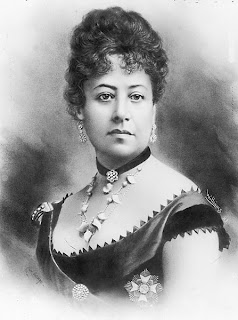In 1836, Honolulu wasn’t really a city; it was just a large village with only one main street, King Street, and less than 6,000 people - about 500 were white foreigners.
It was a major port for whaling ships, and as one writer put it, one of the most "unattractive" places in the world.
Emma, the future queen, was born “Emma Naea” in Honolulu on January 2, 1836 to Fanny Kekelaokalani Young, daughter of John Young, King Kamehameha I's counselor, and Kaʻoanaʻeha, Kamehameha's niece. Her father was high chief George Naea.
As was the custom, she was offered to her mother's sister, Grace Kamaikui Rooke and her husband, Dr. T.C.B. Rooke as hānai daughter. Unable to have children of their own, the Rookes adopted Emma.
Emma grew up speaking both Hawaiian and English, the latter “with a perfect English accent.” She began formal schooling at age 5 in the Chief's Children's School, where she was quick and bright in her studies.
At age 13, Dr. Rooke hired an English governess, Sarah Rhodes von Pfister, to tutor young Emma. He also encouraged reading from his extensive library. As a writer, he influenced Emma's interest in reading and books.
At 20, Emma became engaged to the king of Hawai‘i, Alexander Liholiho, (Kamehameha IV,) a 22-year-old who had ascended to the throne in 1855. The couple had known each other since childhood.
At the engagement party, accusations were made that Emma's Caucasian blood made her not fit to be the Hawaiian queen, and her lineage was not suitable enough to be Alexander Liholiho's bride.
However, the wedding was held as planned however, and the new queen soon became involved in the business of the kingdom, particularly that of saving the Hawaiian people from extinction.
In his first speech as King, Kamehameha IV stated the need for a hospital to treat the native population. Due to introduced diseases, the Hawaiian population had plummeted since the time of Captain Cook's arrival to 70,000, with extinction a very real possibility.
The treasury was empty, so the king and his queen undertook the mission of soliciting enough funds to establish a proper hospital in Honolulu. Within a month, their personal campaign had raised $13,530, almost twice their original goal.
To recognize and honor Emma's efforts, it was decided to call the new hospital "Queen's."
The King and Queen rejoiced at the birth of their son, Albert Kauikeaouli Leiopapa a Kamehameha, on May 20, 1858. The entire populace welcomed the new heir to the throne with joy, only to be stricken by utter grief four years later when the little boy died suddenly of "brain fever."
Just 15 months later, Alexander Liholiho, (Kamehameha IV,) weakened by chronic asthma, died at age 29. In her grief, Queen Emma took a new name, Kaleleonalani, which means “flight of the heavenly chiefs.”
To ease her pain, Emma dedicated herself to many worthy causes, among which was organizing a hospital auxiliary of women to help with the ill. She also helped found two schools, St. Andrews Priory in Honolulu and St. Cross on Maui. Her work included the development of St. Andrews Cathedral. She journeyed to England where she and her friend, Queen Victoria, raised $30,000 for the construction or the cathedral.
“Queen Emma, or Kaleleonalani, the widowed queen of Kamehameha IV … refined by education and circumstances … is a very pretty, as well as a very graceful woman. She was brought up by Dr. Rooke, an English physician here, and though educated at the American school for the children of chiefs, is very English in her leanings and sympathies, an attached member of the English Church, and an ardent supporter of the “Honolulu Mission.” Socially she is very popular, and her exceeding kindness and benevolence, with her strongly national feeling as an Hawaiian, make her much beloved by the natives.” (Bird)
When King Lunalilo died in 1874, Emma became a candidate for the throne (the Kingdom had become a constitutional democracy). Lunalilo had wanted her to succeed him, but he failed to make the legal pronouncement before he died.
An election for a new sovereign was held. Although she campaigned actively, she lost the throne to David Kalākaua.
Politics was not her strong suit -- humanitarianism was. Queen Emma was much loved by the people and hundreds of mele have been composed in her honor. Her humanitarian efforts set an example for Hawaii's royal legacy of charitable bequests.
After her death on April 25, 1885 at age 49, she was given a royal funeral and laid to rest in Mauna ʻAla beside her husband and son.
“She was different from any of her contemporaries. Emma is Emma is Emma. There’s no one like her. A devout Christian who chose to be baptized in the Anglican church in adulthood, and a typically Victorian woman who wore widow’s weeds, gardened, drank tea, patronized charities and gave dinner parties, she yet remained quintessentially Hawaiian.” (Kanahele)
“In a way, she was a harbinger of things to come in terms of Hawaii’s multi-ethnic, multi-cultural society. You have to be impressed with her eclecticism — spiritually, emotionally and physically. She was kind of our first renaissance queen." (Kanahele)
Queen Emma left the bulk of her estate, some 13,000 acres of land on the Big Island and in Waikiki on Oahu, in trust for the hospital that honors her. (Lots of good information here came from Queen’s Hospital)
The image shows Queen Emma; in addition, I have added some other images in a folder of like name in the Photos section on my Facebook and Google+ pages.
Follow Peter T Young on Facebook
Follow Peter T Young on Google+
© 2013 Hoʻokuleana LLC

No comments:
Post a Comment